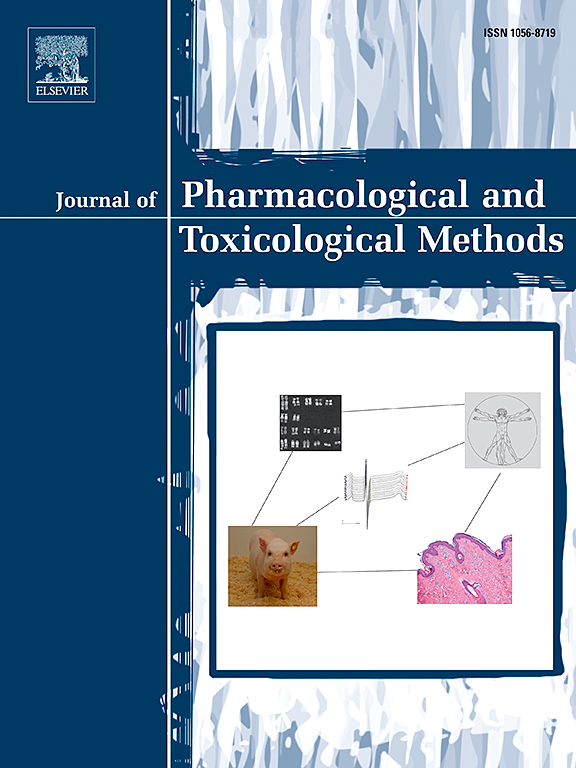化学计量辅助分光光度法同时测定盐酸苯肾上腺素、马来酸氯苯那敏和对乙酰氨基酚的含量
IF 1.3
4区 医学
Q4 PHARMACOLOGY & PHARMACY
Journal of pharmacological and toxicological methods
Pub Date : 2025-04-23
DOI:10.1016/j.vascn.2025.107741
引用次数: 0
摘要
建立了一种基于导数比和二阶导数的环保紫外分光光度法,用于同时测定药物混合物中苯肾上腺素(PHE)、马来酸氯苯那敏(CPM)和扑热息痛(PAR)的含量。在导数比法中,将样品光谱除以其他组分的标准化光谱,然后计算一阶导数。二阶导数法采用二阶导数吸收光谱,利用零点交叉点在280.5 nm (PHE)、250.5 nm (CPM)和245.5 nm (PAR)处选择性定量每种药物。导数比法的线性范围为0.1 ~ 30 μg/mL (PHE)、0.5 ~ 36 μg/mL (CPM)和1 ~ 30 μg/mL (PAR);二导数法为3-24 μg/mL (PHE)、1-15 μg/mL (CPM)、1-14 μg/mL (PAR)。导数比法的相对标准偏差小于0.2%,二阶导数法的相对标准偏差小于3%。方法性能以传统HPLC-DAD技术为基准,并使用先进的评估工具对生态友好性和绿色度进行评估。将该方法有效地应用于商业制剂,验证了其可靠性和环境相容性。本文章由计算机程序翻译,如有差异,请以英文原文为准。

Chemometrics-assisted spectrophotometric method for the simultaneous determination of phenylephrine hydrochloride, chlorpheniramine maleate and paracetamol
This study presents an eco-friendly, combined UV spectrophotometric method based on derivative ratio and second derivative for the simultaneous determination and quantification of phenylephrine HCl (PHE), chlorpheniramine maleate (CPM), and paracetamol (PAR) in pharmaceutical mixtures. In the derivative ratio method, sample spectra are divided by standardized spectra of the other components, followed by calculation of the first derivative. Analysis was performed at 226 nm for PHE, 271 nm for CPM, and 253 nm for PAR. The second derivative method uses second-order derivative absorption spectra, using zero-crossing points to selectively quantify each drug at 280.5 nm for PHE, 250.5 nm for CPM, and 245.5 nm for PAR. The linearity ranges were 0.1–30 μg/mL (PHE), 0.5–36 μg/mL (CPM), and 1–30 μg/mL (PAR) for the derivative ratio method; and 3–24 μg/mL (PHE), 1–15 μg/mL (CPM), and 1–14 μg/mL (PAR) for the second derivative method. The relative standard deviations were below 0.2 % for the derivative ratio method and below 3 % for the second derivative method. Method performances were benchmarked against a conventional HPLC-DAD technique and the eco-friendliness and greenness were evaluated using advanced assessment tools. The proposed method was effectively applied to commercial pharmaceutical formulations, confirming its reliability and environmental compatibility.
求助全文
通过发布文献求助,成功后即可免费获取论文全文。
去求助
来源期刊

Journal of pharmacological and toxicological methods
PHARMACOLOGY & PHARMACY-TOXICOLOGY
CiteScore
3.60
自引率
10.50%
发文量
56
审稿时长
26 days
期刊介绍:
Journal of Pharmacological and Toxicological Methods publishes original articles on current methods of investigation used in pharmacology and toxicology. Pharmacology and toxicology are defined in the broadest sense, referring to actions of drugs and chemicals on all living systems. With its international editorial board and noted contributors, Journal of Pharmacological and Toxicological Methods is the leading journal devoted exclusively to experimental procedures used by pharmacologists and toxicologists.
 求助内容:
求助内容: 应助结果提醒方式:
应助结果提醒方式:


